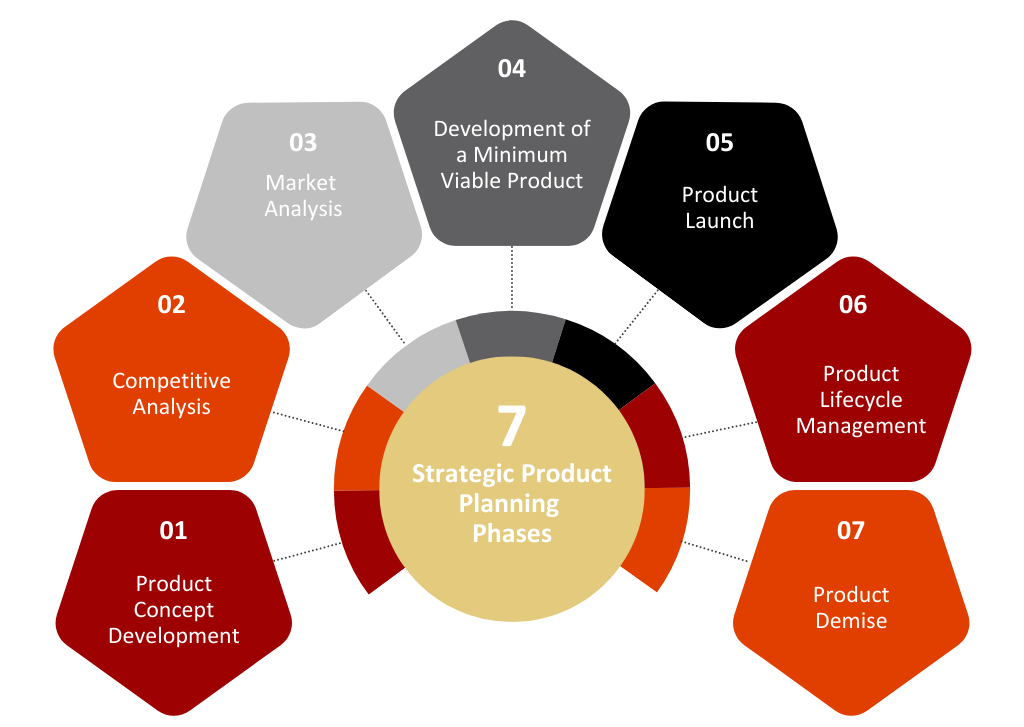The 7 Strategic Product Planning Phases

Introduction
Product planning is essential for firms that develop, manufacture, and sell goods. With a product development plan, businesses can assess their current consumer demographics, identify potential for expansion, and create product development goals that help them gain, retain, and service their consumers.
In this blog, we’ll explore the fundamentals of product planning—a crucial process for companies involved in creating, manufacturing, and selling goods. We’ll break down the seven strategic product planning phases and discuss how to craft a successful product planning strategy.
Join us as we simplify the complexities of product development, focusing on attracting, retaining, and serving consumers.
What is Product Planning?
Product planning involves creating useful goods for consumers. The development cycle includes market research, planning, design, production, and pricing. A product development plan sets achievable goals, tracks progress, and allows for adjustments.
“Product planning is not a one-time event or meeting”
A widespread misperception among product owners is that “product planning” is only an activity that occurs once during the early stages of a product’s development. They can have a single meeting with their stakeholders to help determine, for example, which major topics to prioritize, who their target consumers are, and what their basic price structure should be. They then go right into execution mode, without returning to any of these big-picture strategic considerations.
However, the ground realities can alter. The modifications emphasize the significance of not considering product planning as a one-time event. Product planning is still an important strategic component of the process.
One advantage of including product planning as an ongoing element of your role in developing a new framework. This permits you to update your original planning if changes are required.
7 Strategic Product Planning Phases
While no two products follow the same path, there are several common stages that virtually all must pass through. Here’s what you can expect from the first phase to the final phase.

- Product Concept Development
The exciting part is coming up with a product concept. Creating ideas, finding pain spots and challenges to tackle, and picturing the joy and fulfillment your product can provide. It’s a time for hope and potential.
When an idea has received sufficient support, it is time to verify it during product discovery, ensuring that this notion is viable through additional inquiry and investigation. These insights and concept critiques aid in the refinement of the concept.
- Competitive Analysis
You’re probably not the first to think of this brilliant concept, so it’s time to check what else is out there. If you’re late to the game and others are already executing, you can see where they’re falling short and what areas of the market they’ve already secured.
This activity’s outcome indicates if you’re actually forging new ground or just attempting to be a disruptor. You’ll know what you’re up against if you decide to move forward if you have a clear grasp of the competitive landscape.
- Market Analysis
Qualitative and quantitative research assists businesses in grasping the true potential. How many people will be interested in your product? What is the value of a solution to them?
By determining the entire addressable market, the team can determine whether it is worthwhile to commit technical resources and begin making it a reality. You’ll also create the framework for later planning your go-to-market strategy.
- Development of a Minimum Viable Product
Creating an MVP allows you to present prospects with something more concrete than a sleek landing page or slide show. It’s the greatest way to see if your concept resonates with users and tackles the pain areas and difficulties that inspired your original thought.
Creating the “minimum” element of the MVP also marks the first — of many — occasions when you must prioritize what is most important. Using a framework simplifies this and removes some of the subjectivity from making such decisions.
The response to your MVP and subsequent product modifications create the foundation for your initial release.
- Product Launch
Your great idea has matured into a product, and it’s time to release it to the world with a well-thought-out product launch. Product marketing will be fully involved as they A/B test landing pages, marketing slogans, and pricing points to maximize a new release’s early excitement.
The product positioning and outlets to promote the launch are all part of the strategy when you peel back the curtain. Meanwhile, the analysts go through the data and feedback, starting a new round of learning.
- Product Lifecycle Management
Now that the product is established, it’s all about the product plan and incremental releases to solve issues. This offers added value while also broadening the market. As the company strives to meet its strategic goals and develop new ones, planning will center on themes.
The product life cycle stage encompasses the product’s time of fast expansion. Furthermore, the product will hopefully take several years to complete. SWOT analysis and other introspective exercises highlight what has to be done to strengthen things and map a road for long-term success. New functionality and target markets can develop as a result of the success of previous releases.
- Product Demise
Most goods ultimately experience diminishing returns. As clients move on to the next generation of solutions there is minimal reward in investing extra product development resources or marketing investment.
However, this process takes time; occasionally, the business wants to maximize the income it can extract from its diminishing customer base. While this can occasionally result in a pivot and renewed life for the product, more often than not, it merely leads to a steady fall in usage until it’s time to eventually pull the plug and migrate the surviving user base to something else.
How to define a better product planning Strategy?
Product planning is an ongoing aspect of product management that pervades everything we do as product managers in order to produce successful products.
- How should the product planning aspect of our job be structured?
- When and who should we involve?
- Should we also schedule product planning?
Here are some guidelines to help you develop your own product planning culture.
- Cultivate a culture where product planning is seen as a continuous process.
Businesses don’t want to change your primary objective every other week, of course. However, they should not feel obligated to a set of strategic ideas derived from a single meeting held months ago. Just because it was dubbed it a “product planning meeting” and everyone agreed on the decisions at the time does not mean they are still final.
- Create a regular communication culture throughout the product development process.
Businesses have modified its thinking and recognize that product planning can require a shift in priority when strategic realities demand it. In such a situation, businesses should interact with their team more frequently—and urge them to communicate more frequently as well.
Because early-stage decisions are more changeable, you can modify your strategy at any time along the process. Colleagues can potentially recommend revisions to strategy plans if they know they can make adjustments if they have the facts or insights to back them up. For these reasons, businesses should communicate more regularly across the organization to ensure that everyone is aware of any upgrades
- Summarize your research with conclusions and key takeaways
The need for a well-defined vision and clear objectives emerged. Any project can rapidly deteriorate its course without a firm vision, emphasizing the necessity of starting with a strong sense of purpose. Market research and audience analysis were shown to be crucial in offering vital insights into feasibility and market dynamics.
Setting quantifiable objectives and key performance indicators (KPIs) has been acknowledged as a critical practice for maintaining focus and measuring success. Prioritizing features based on their alignment with overall objectives guarantees that the fundamental value remains preserved even when resource restrictions exist.
Last Thought
Product development and planning can appear difficult, but they do not have to be. With KaarTech, unique perspective, critical thinking skills, and ability to engage across several teams are incredibly valuable in the product planning process.
Businesses can take an active part in bringing breakthrough goods to market and driving success by demystifying R&D-driven technologies and understanding the core ideas.
Do you seek further insights or have inquiries, don’t hesitate to reach out to KaarTech. Our expert team is ready to guide you on the path to innovation and achievement.
FAQ’s
What is Product Planning?
Product planning involves creating useful goods for consumers, encompassing market research, design, production, and pricing. A dynamic product development plan sets goals, tracks progress, and allows for adjustments.
Is Product Planning a One-Time Event?
No, product planning is not a one-time event. It’s an ongoing strategic component of the product development process. Regularly updating plans ensures alignment with changing market dynamics and business goals.
What are the Key Phases in Strategic Product Planning?
Strategic product planning comprises phases such as concept development, competitive analysis, market analysis, minimum viable product (MVP) creation, product launch, lifecycle management, and eventual product demise.
How to Define an Effective Product Planning Strategy?
Cultivate a continuous product planning culture, emphasizing adaptability. Establish regular communication throughout the development process, allowing for adjustments based on insights. Prioritize a well-defined vision and set quantifiable objectives and key performance indicators (KPIs) for success.

